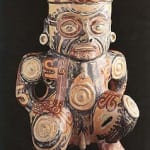Galo Polychrome Kneeling Male Figure, 500 CE - 1000 CE
Terracotta
13.25
PF.3615
This kneeling male figure comes from the Guanacaste-Nicoya polychrome tradition, the Galo polychrome style. Its mirror-bright burnished surfaces are technically unsurpassed by any Pre-Columbian pottery, and yellows, reds, oranges, creams,...
This kneeling male figure comes from the Guanacaste-Nicoya polychrome tradition, the Galo polychrome style. Its mirror-bright burnished surfaces are technically unsurpassed by any Pre-Columbian pottery, and yellows, reds, oranges, creams, maroons, and blacks of the polychrome decorations are impressively vivid. Among such sculptures are the full human figures with elaborate representations of tattoos or body paint. Such brilliant polychrome tradition represent an important social dimension; when the northern trade network that brought jade, slate-backed pyrite mirrors, foreign ceramics, and other luxury goods, the nicoyans responded by producing their own special purpose pottery. Inspired by northern models, it also incorporated local and southern elements, forming a dazzling hybrid style that was traded around Central America and southern Meso-America in the centuries to come. This colorful and dazzling figure is covered with patterns and symbols, which indicate body painting or tattoo. Not only is the figure elaborately painted but it also shows various bodily ornamentation such as the knotted headband and the large earspools. The detailed enhancement suggests that the figure is a representation of a high ranking or an important person, perhaps a warrior, a chieftain, or a priest. His noble posture connotes pride and honor, and his shoulders and knees are further enhanced with coiling marks that perhaps indicate his status. This magnificent sculpture brings the brilliance of the ancient art and history to us in the most dramatic manner.
Literature
V16



